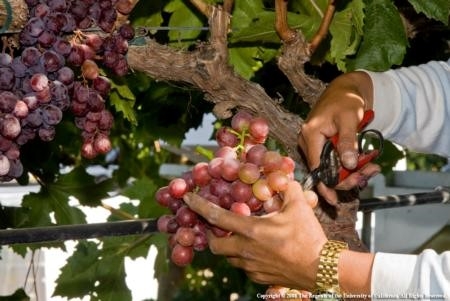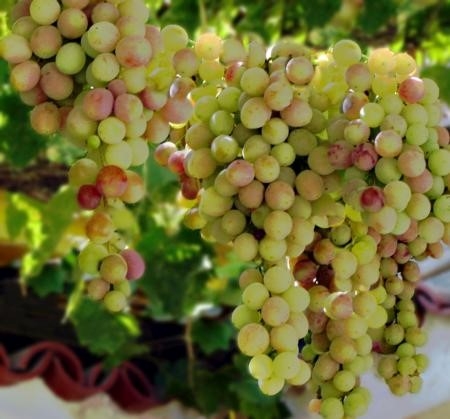- Author: Help Desk Team
According to someone who knows such things, grapes are one of the most widely cultivated fruit crops in the world. Worldwide, there are over 10,000 different varieties, and whether one's interest is ambience, erosion control, raisins, jelly, table munchies, or wine, grapes nicely fit the bill. While grapevines are relatively hardy, they still need year-round care to be most productive.
There are extensive data regarding the growth and maintenance of grapes. Specific recommendations for when/where/how and why will depend upon some critical factors like soil type, location, sun exposure, grape variety, and more.
There are a few generalities that are helpful to home gardeners wanting grapes to be an integral part of their garden landscape.
- First, grapes need sun, full sun if possible, because less light results in lower fruit production, poorer fruit quality, and an increased incidence of certain diseases like powdery mildew.
- Second, grapevines can thrive in a variety of soil types, but good drainage is critical. Grape roots can be very extensive and deep, so ideally there should be 3–4 feet of soil above hardpan or rock layers. Table grapes tend to grow quite well on less fertile soils. On poorly drained soil, a large amount of well-decomposed compost should be incorporated before planting.
- Third, grapes need space, the amount of which is dependent upon the desired use of the fruit. Spacing between rows of wine grapes can be as little as 8 feet up to as much as 12 feet in very deep rich soils. Home grapes are often grown on arbors and in that situation one vine would require 50–100 square feet of arbor space. If the interest is only a few grapevines, then a space of at least 3 feet between plants would be a minimal requirement.
- Fourth, water requirements vary as a function of soil type and plant maturity. Water leaches quickly from sandy soils while it tends to collect in heavy clay. New vines should be watered weekly, sufficient to wet the soil 6–10 inches deep. Some recommendations suggest ½–1 inch of water/week for new vines. Five gallons of water spread over a 3' x 3' area is equal to about 1 inch of water. Established vines (over 2 years) can be relatively drought tolerant, but regular watering down to 12 inches will improve productivity. Once vines set fruit, watering can be reduced. Given that water use is so dependent upon a variety of factors like soil type, slope, sun exposure, it is difficult to prescribe a specific water regimen that is applicable to all.
Grapes can be grown from bare root preparations, usually with a fruiting cane grafted onto a disease resistant rootstock; this is probably the safest way to proceed. Alternatively, most grapes can be propagated as ‘own rooted' where a mature cane is simply placed in potting soil. This can be very successful, but the resultant vines are not disease resistant.
Canopy management is extremely important not only for optimization of fruit quality but also for management of potential problems, like powdery mildew. Shoot thinning is done primarily to reduce shoot congestion in the fruiting zone and to adjust flower cluster numbers. In addition to reducing the number of shoots emerging from the crown of the vine, the canes or the spurs, it is also important to strip leaves to increase light and reduce humidity in the fruit zone. However, in areas that can be very hot, it is important that there is adequate leaf coverage over the fruit to reduce sunburn or fruit shrinkage.
Proper pruning is critical to maintain good plant structure, optimize productivity and allow adequate vegetative growth for the following season. Unpruned vines will have excessive numbers of grape clusters and the vine will be unable to ripen the large crop. Pruning is done when the vines are dormant and just before bud break. Mid to late February is a good time in most of Contra Costa County. There are many approaches to pruning which depend, primarily, upon how the grapes are grown. This website has more information about pruning: https://ipm.ucanr.edu/PMG/GARDEN/FRUIT/CULTURAL/grtrainprune.html
Like any plant, there are various types of diseases or conditions that can seriously impact grapevines. Some of the most notorious, such as phylloxera (an aphid-like insect that can destroy roots) or nematodes, can be managed by using disease-resistant rootstock stock. There are many other potentially serious conditions but in the home garden the most likely condition the homeowner will encounter is powdery mildew. This is caused by a fungus that does remarkably well in warm Mediterranean-type climates like ours. The mildew can affect leaves, stems, and fruit and grows on the surface of the affected plant part.
The best management of powdery mildew is prevention, which involves good cultural practices (e.g., canopy management for good air circulation) and, if necessary, fungicide applications. Fungicides can act as protectants, eradicants, or both. Protectants, such as sulfur, prevent new infections from occurring while eradicants like the oils (Neem, Stylet) can control as well as protect against infection. If conditions are right and/or if mildew is detected, protectants and eradicants should be used in 7–10-day intervals. These treatments should not be done when temperatures are near or over 90° F.
There are a number of invertebrate pests that can attack grapes, most notably thrips, leafhoppers, and mealybugs. UCANR has an extensive website that documents the various pests and their control. There are also a number of vertebrate pests that can cause considerable damage to the vines and/or the fruit including birds, raccoons, ground squirrels, gophers, rabbits, and deer. Exclusion techniques (netting, electrical fences, etc.) are the best management techniques for such pests.
For more information about growing grapes, see these websites: https://ipm.ucanr.edu/PMG/GARDEN/FRUIT/grapes.html https://ucanr.edu/sites/gardenweb/Growing_Grapes_in_the_California_Garden/
In spite of the potential problems identified above, grapes are hardy, resilient, and forgiving plants that not only have aesthetic qualities but also provide a wide range of culinary attributes. Give grapes a try—it's worth it.
Help Desk of the UC Master Gardeners of Contra Costa County (JRF)
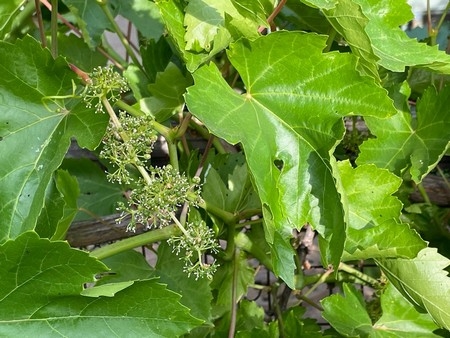
Advice for the Home Gardener from the Help Desk of the
UC Master Gardener Program of Contra Costa County
Help Desk Request: I'm delighted you're available to help diagnose garden problems! Below are four pictures of a grape leaf problem. I have four old vines - Flame and Thompson seedless - that grow against a south-facing solid fence. The vines are close enough that they are co-mingled across the fence. The problem currently is located in one area of the vines and was not visually noticeable three weeks ago. All the vines are vigorous and seem healthy except for the affected leaves. I have cut most of the leaves and vines that are visibly distressed and placed them in my green waste bin. In the 15+ years I've had the grapes I have never had this problem; however, this year I was VERY, VERY late in pruning back the vines, and did not complete the pruning until the new vines had grown a couple feet long. Perhaps the evil villain over-wintered because of my tardy pruning?
Any idea what the problem is - fungus, bug or insect critter, bacteria? I have not seen anything crawling on either side of the leaves. And, what is your recommended approach and treatment? Thanks in advance for your help!
Submitted Representative Images of Affected Grape Leaves (below)
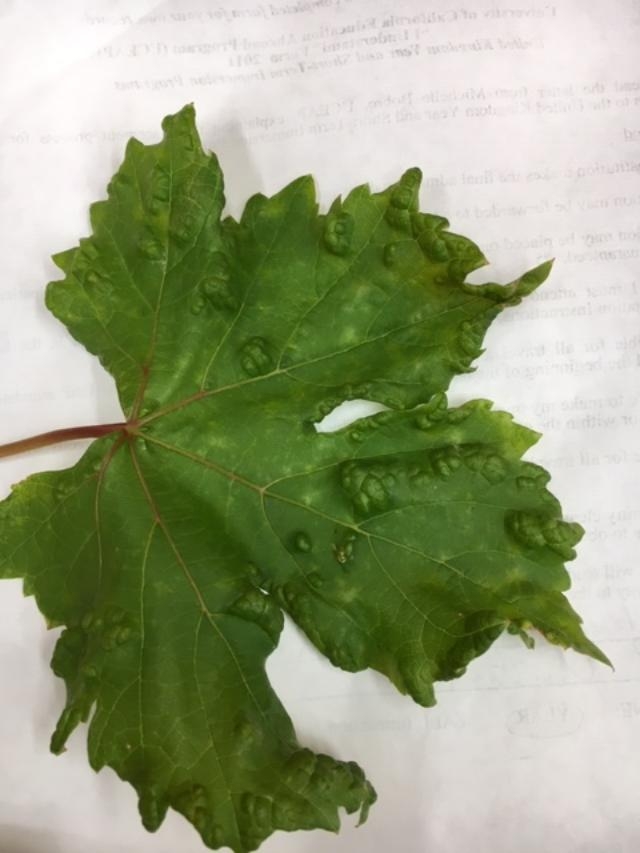
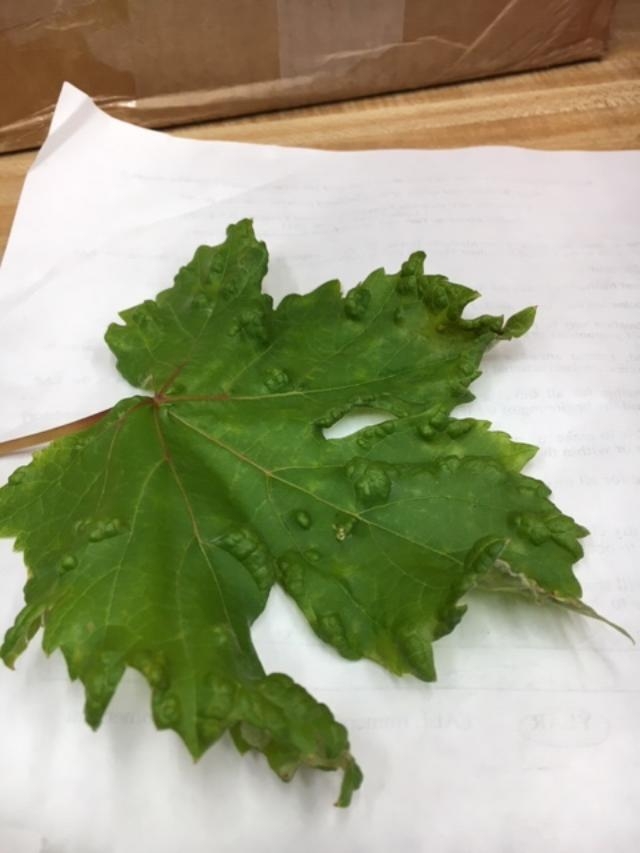
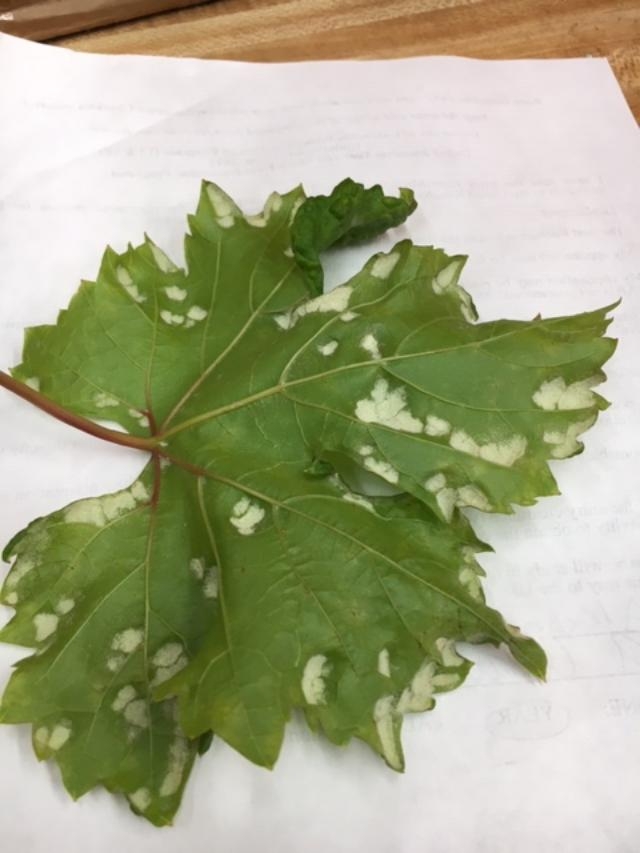
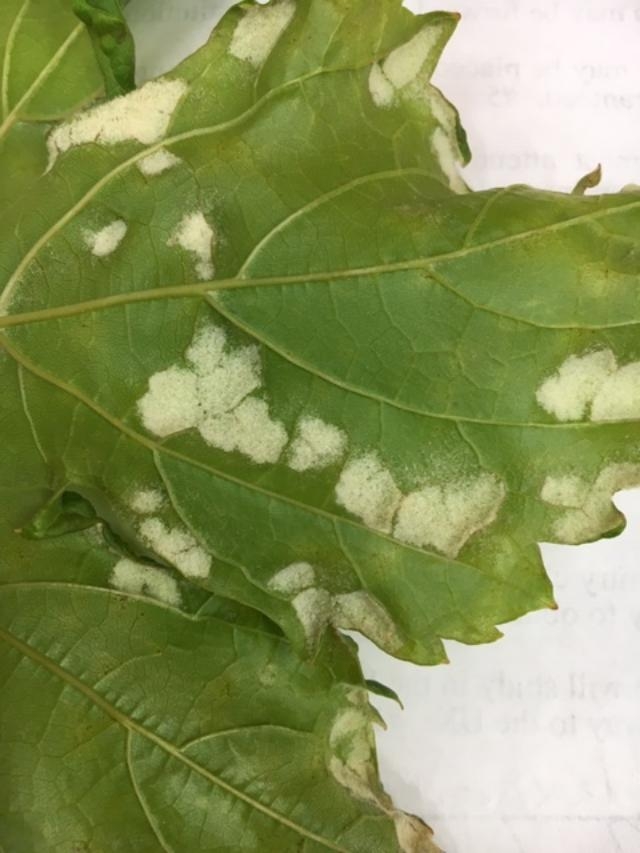
MGCC Help Desk Response: Thank you for contacting the UC Master Gardener Help Desk with your issue of ‘bumps and holes' on your grape leaves.
Thank you for the pictures and note that the blister is on the top of the leaf and the bottom shows fuzzy white. We were able to diagnose simply from the damage itself. The bumps are the result of mites – specifically grape erineum mites. The good news here is that even though the mites infest the leaves, no management is necessary as they rarely lead to any crop losses.
Erinium mites are wormlike, light yellowish white and microscope so you really would need magnification to see the actual mites themselves.
Young leaves show bright pinkish or reddish swellings on upper surfaces. Corresponding areas on lower surfaces are concave and densely lined with a felty mass of plant hairs
The mites overwinter under outer bud scales and move to unfolding leaves in spring. They associate in small groups to feed on lower leaf surfaces; the result is production of masses of enlarged leaf hairs inside a blisterlike area on the leaf. On the undersides of the leaves, beneath the swellings, are concave, densely lined, felty masses of oversized leaf hairs in which the mite populations develop. As the population increases, some move to new areas or to other leaves. From mid-August to leaf drop, there is a movement back to the overwintering site underneath the bud scales.
You indicated that this is new to you and that you were a bit late pruning. I cannot explain for sure why this year and not prior years and I cannot be sure the late pruning added to this situation.
Following is a link to a UC Pest Management website on the subject but it does not really add to the information I have provided above. http://ipm.ucanr.edu/PMG/GARDEN/FRUIT/PESTS/grerineummte.html
Good luck and enjoy those grapes, and do not hesitate to contact us again with garden problems.
Help Desk of the UC Master Gardener Program of Contra Costa County (EDC)
Note: UC Master Gardeners Program of Contra Costa's Help Desk is available almost year-round to answer your gardening questions. Except for a few holidays (e.g., last 2 weeks December), we're open every week, Monday through Thursday for walk-ins from 9:00 am to Noon at 2380 Bisso Lane, Concord, CA 94520. We can also be reached via telephone: (925) 608-6683, email: ccmg@ucanr.edu, or on the web at http://ccmg.ucanr.edu/Ask_Us/. MGCC Blogs can be found at http://ccmg.ucanr.edu/HortCoCo/ You can also subscribe to the Biog.
Advice for the Home Gardener from the Help Desk of the
UC Master Gardener Program of Contra Costa County
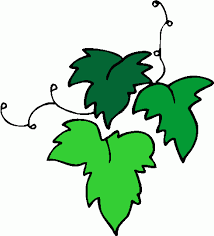
MGCC's Help Desk Response: Thank you for contacting the UC Master Gardener Program Help Desk with your questions about grape culture.
Based upon the information you have provided, here are several reasons your grapevines may not flower and produce grapes:
- Grapevines need full sun to activate the flower blossoms. Without sufficient sunlight, the flower buds won't develop properly.
- Pruning the vines incorrectly may affect the blossoms. Most wine grapes are pruned severely in the winter, leaving only short spurs on the woody trunk and main branches. However, some grape varieties, such as "Concord," "Crimson Seedless" and "Thompson Seedless" are cane pruned. These varieties require longer branches, or canes, because the lowest buds may not produce fruitful vines. The non-productive vines should be trimmed back in spring and early summer to prevent them from shading the developing flower buds and blocking the sunlight, thus reducing the number of flowers produced that season.
- Grapevines thrive in well-drained, rich soil. However, if the soil contains too much nitrogen, or if you've over-fertilized, the grapevine may put all of its energy into foliage instead of flowers and fruit.
- Grapevines harbor a variety of pests that can affect the development of flowers and fruit.
- Grape blossoms are mostly wind pollinated, however, varieties that require both a male and female plant require cross pollination to produce fruit. This may be accomplished by wind or insects
Following are several links from UC leading to further useful information about grape culture and pests. These links also cover and expand on the reasons for lack of flowering and production listed above:
http://ipm.ucanr.edu/PMG/GARDEN/FRUIT/grapes.html
http://cagardenweb.ucanr.edu/Growing_Grapes_in_the_California_Garden/
Hope that information helps. Please do not hesitate to contact the Help Desk again if you have further questions.
Help Desk of the UC Master Gardener Program of Contra Costa County (SLH)
Note: The UC Master Gardeners Program of Contra Costa's Help Desk is available year-round to answer our gardening questions. Except for a few holidays, we're open every week, Monday through Thursday for walk-ins from 9:00 am to Noon at 75 Santa Barbara Road, 2d Floor, Pleasant Hill, CA 94523, although we will be moving this spring. We will notify you if/when that occurs. We can also be reached via telephone: (925)646-6586, email: ccmg@ucanr.edu, or on the web at http://ccmg.ucanr.edu/Ask_Us/ MGCC Blogs can be found at http://ccmg.ucanr.edu/HortCoCo/ You can also subscribe to the Blog (http://ucanr.edu/blogs/CCMGBlog/)
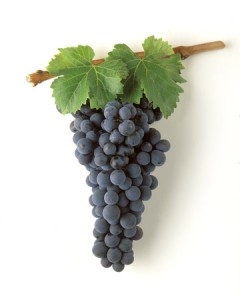
of the Master Gardeners of Contra Costa County
Client's Request: (via earlier phone call) I have Zinfandel grapes in my backyard garden. Looking at them now it appears that they aren't providing me with a good harvest. I'm concerned about pruning them this winter to get the best harvest. Would you please provide me with the appropriate information about pruning Zinfandel grape vines.
MGCC's Help Desk Response: Thank you for contacting Master Gardeners with your Zinfandel grape pruning question. I understand that when you phoned our offices, the Master Gardener with whom you spoke mentioned that we occasionally have presentations on growing and caring for grapes. Right now, we have only one such presentation on the calendar. It will occur at “Our Garden” on Saturday, October 3, beginning at 10 a.m (click for more info). Our Garden is a demonstration garden that is maintained by our Master Gardener program. It is located at the corner of Wiget Lane and Shadelands Drive in Walnut Creek. This link will take you to a map where you can download driving directions: http://ccmg.ucanr.edu/?mapd=&calnum=267082
I believe that the presenter at Our Garden will demonstrate grape pruning on table grapes that grow in the garden. However, he is quite knowledgeable about grapes and will probably reserve some time to answer questions that attendees may have after seeing the demonstration.
Now for some general information about pruning Zinfandel grapes. As you may know, there are two primary systems of pruning for grapes. The system you use is based on the variety of grapes you are growing. Zinfadel grapes are typically spur pruned. (The other pruning system is called cane pruning.)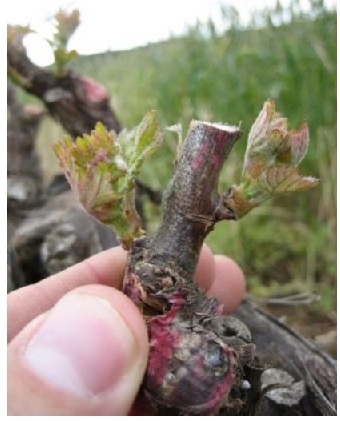
Pruning of grape vines typically occurs in the dormant season (any time after the leaves have fallen from the plants and before new growth begins the following spring… usually mid to late winter.)
In the first year the grapes are pruned, start by cutting each plant back to a single two bud spur. Page 11 of the PowerPoint presentation slides at this link shows a photograph of a two bud spur: http://afghanag.ucdavis.edu/a_horticulture/fruits-trees/grapes/presentations-powerpoint/PPT_Grape_Pruning_Systems.ppt. Keep in mind that the photo was taken after the buds had begun growing. When you do your pruning, the buds will not yet have begun growing.
When the plants start growing, you'll need to decide whether you are going to train them as bilateral cordons attached to a trellis or “head train” them which uses stakes to support the plants but does not require a trellis system.
This publication on growing Zinfadel from the University of California indicates that either cordon training or head training can be used for Zinfandel grapes: http://iv.ucdavis.edu/files/24366.pdf As you'll see in the article, the author indicates that many Zinfandel growers prefer to use head training. The reason is that Zinfandel tends to overcrop easily, and if the fruit is not thinned, it will ripen with difficulty or not at all. Because head training produces fewer fruiting spurs than cordon training, using head training will reduce the chance that you will accidentally allow too many grape clusters to remain on the plant.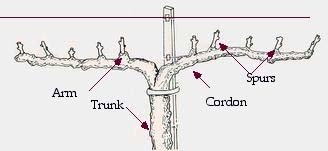
with spur pruning
Here is a UC diagram that illustrates how a bilatereal cordon trained spur pruned grapevine will look:
The best illustration I located of what head pruned grapevines look like appears on page 16 of this Oregon State University publication: http://ir.library.oregonstate.edu/xmlui/bitstream/handle/1957/21285/ec1639.pdf The OSU publication focuses on table grapes, but the pruning principles would apply equally well for wine grapes.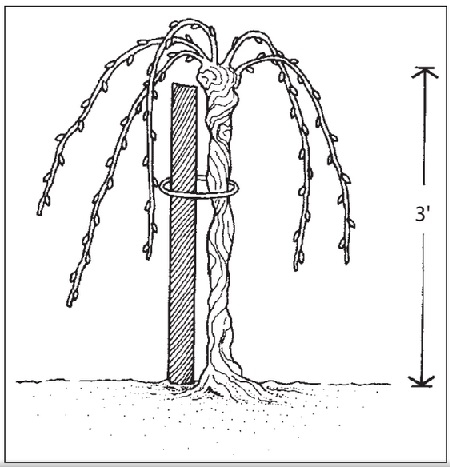
Finally, keep in mind that once your vines are mature and fully trained, you'll need to do annual pruning to prompt development of new grapes and to keep them producing well. The OSU publication as well as the UC article on head-pruning also contain good information about pruning of mature, fully trained vines.
I hope that this information is helpful and that you have an opportunity to attend the presentation at Our Garden on October 3. You are welcome to contact us again if you have additional questions.
Help Desk of the Master Gardeners of Contra Costa County
Note: The Master Gardeners of Contra Costa's Help Desk is available year-round to answer your gardening questions. Except for a few holidays, we're open every week, Monday through Thursday for walk-ins from 9:00 am to Noon at 75 Santa Barbara Road, 2d Floor, Pleasant Hill, CA 94523. We can also be reached via telephone: (925) 646-6586, email: ccmg@ucanr.edu, or on the web at http://ccmg.ucanr.edu/Ask_Us/
Client's Question and Request:
I'm in central county and growing Zinfindel Grapes in my backyard garden. The vines are now several years old and producing fruit this year. The grape leaves have now developed “blotches” and the grapes look “cloudy” and not very healthy. What's the problem and what can I do about it? The pictures below show the leaf damage and what the grape bunches look like.
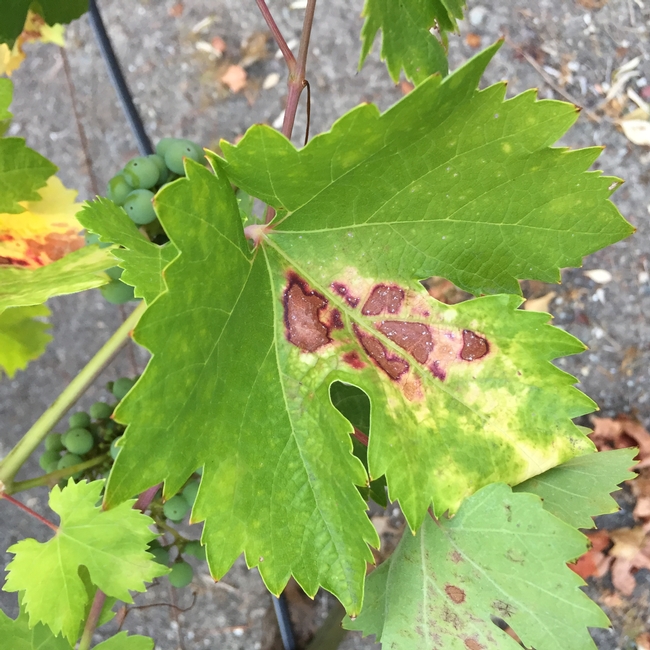
earlier by powdery mildew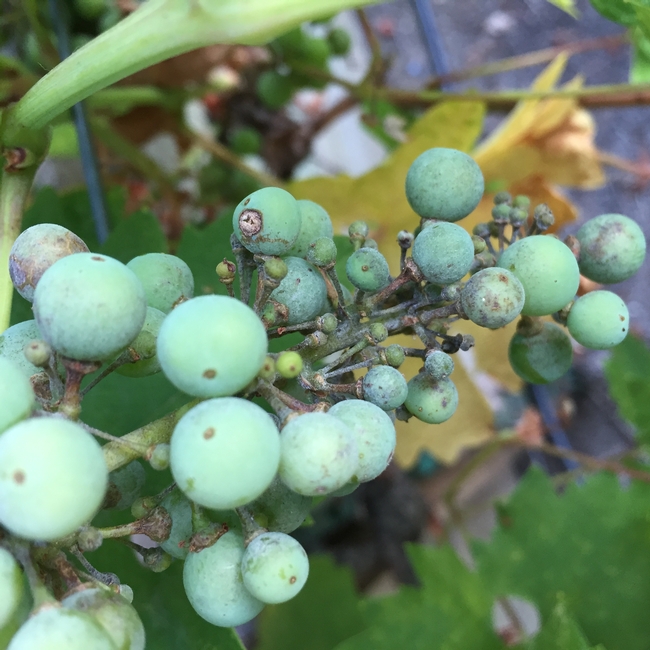
Powdery Mildew
MGCC Help Desk Response and Advice:
Based on the grape samples and the photos you provided, the problem with the grapes appears to be powdery mildew.
Powdery mildew is a common fungal disease on grapes. It first shows up as faint white powder on the grapes but later can progress to cause brown russeting on the developing grapes. That russeting was somewhat apparent on the grape samples you brought in. Affected fruit cannot ripen normally and may crack as it grows.
Shady conditions and lack of good air circulation favors the development of the disease on grapes. When the vines are pruned iduring dormancy so that shoots are positioned in the next growing season, try to prune so that the plants will allow exposure of the developing fruit to sunlight and good air circulation. Avoid overhead watering of the vines which can spread the fungal spores to new locations.
Next growing season, watch closely for the appearance of powdery mildew. Early signs of a developing problem include young emerging leaves being deformed or showing a puckered condition. Prune out such areas as soon as they appear and it may help to prevent new infections.
If you lose a large percentage of the grapes this season, you may also want to consider the use of fungicides to prevent a recurrence next year. Take a close look at this UC website which gives detailed information about different types of fungicide that can be used and includes directions on how and when they should be applied: http://www.ipm.ucdavis.edu/PMG/PESTNOTES/pn7494.html
We hope this information is helpful. You're welcome to contact us again with any further questions
Help Desk of the Master Gardeners of Contra Costa
Note: The Master Gardeners of Contra Costa's Help Desk is available year-round to answer your gardening questions. Except for a few holidays, we're open every week, Monday through Thursday for walk-ins from 9:00 am to Noon at 75 Santa Barbara Road, 2d Floor, Pleasant Hill, CA 94523. We can also be reached via telephone: (925) 646-6586, email: ccmg@ucanr.edu, or on the web at http://ccmg.ucanr.edu/Ask_Us/


